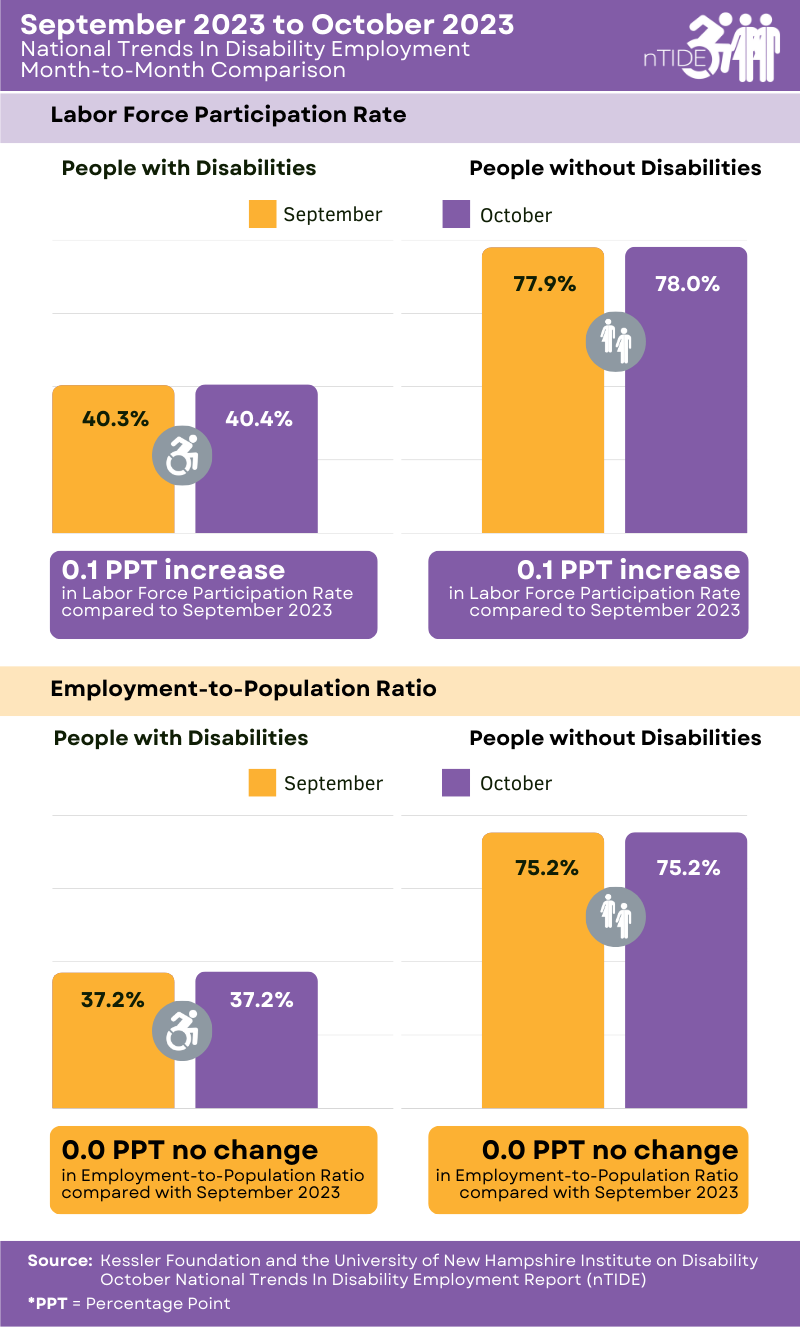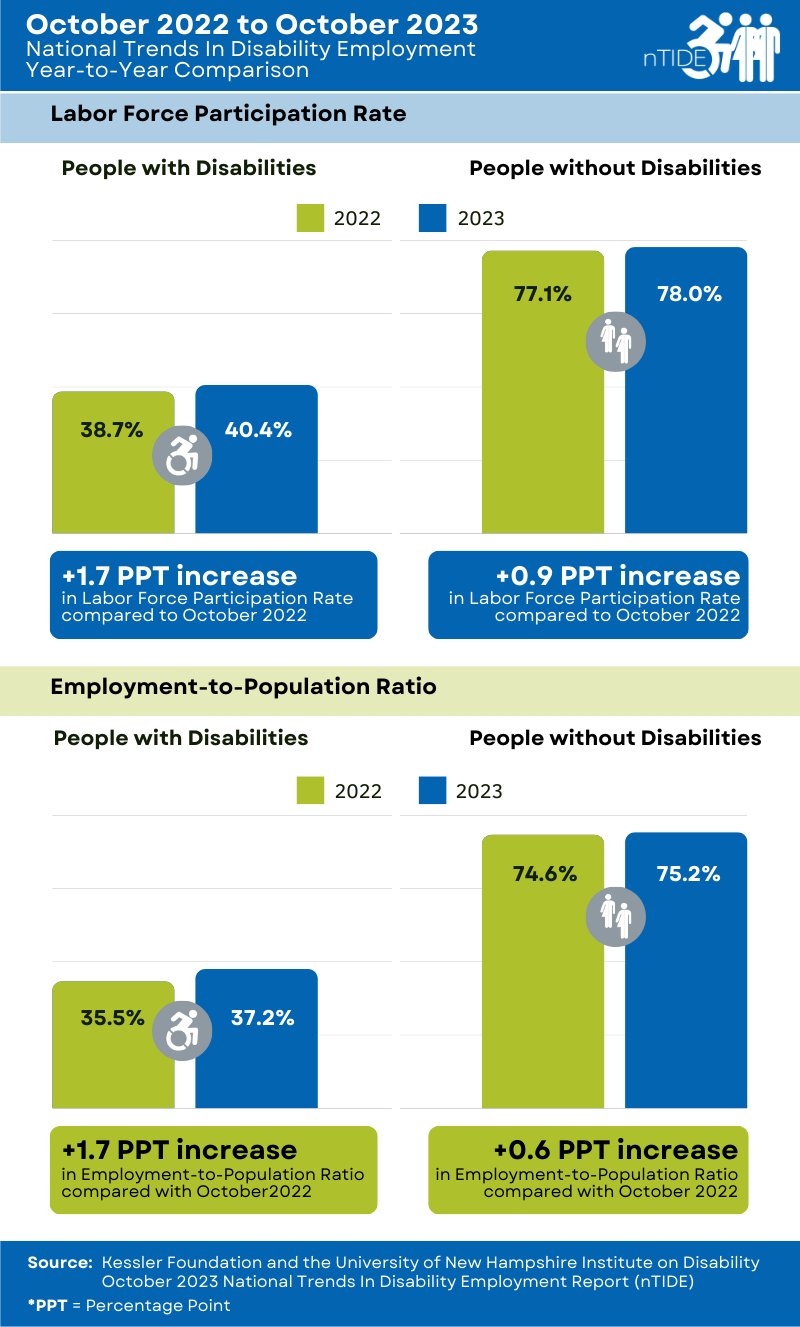National Trends in Disability Employment (nTIDE) – Issued semi-monthly by Kessler Foundation and the University of New Hampshire
East Hanover, NJ – November 3, 2023 – Experts reported little change in October’s employment indicators, as people with disabilities extended their historic highs into the fall, according to today’s National Trends in Disability Employment (nTIDE) – semi-monthly update issued by Kessler Foundation and the University of New Hampshire’s Institute on Disability (UNH-IOD). As anti-inflationary measures exert their cooling effects on the economy, people with disabilities are striving to maintain their gains in the post-pandemic labor market.
Month-to-Month nTIDE Numbers (comparing September 2023 to October 2023)
Based on data from the U.S. Bureau of Labor Statistics (BLS) Jobs Report released today, the employment-to-population ratio for people with disabilities (ages 16-64) remained the same at 37.2 percent for September 2023 and October 2023. For people without disabilities (ages 16-64), the employment-to-population ratio also remained the same at 75.2 percent. The employment-to-population ratio, a key indicator, reflects the percentage of people who are working relative to the total population (the number of people working divided by the number of people in the total population multiplied by 100).

increases in the labor force participation rate for people with and without disabilities, and no changes in the
employment-to-population ratio for people with and without disabilities.
“In October, the employment-to-population ratio for people with and without disabilities remained stable,” according to John O’Neill, PhD, director of the Center for Employment and Disability Research at Kessler Foundation. “People with disabilities are continuing to strive to maintain their historic job gains as the Federal Reserve’s actions begin to curb economic growth,” he added.
The labor force participation rate for people with disabilities (ages 16-64) increased slightly from 40.3 percent in September 2023 to 40.4 percent in October 2023 (up 0.2 percent or 0.1 percentage points). For people without disabilities (ages 16-64), the labor force participation rate also increased slightly from 77.9 percent in September 2023 to 78 percent in October 2023 (up 0.1 percent or 0.1 percentage points). The labor force participation rate reflects the percentage of people who are in the labor force (working, on temporary layoff [on furlough], or actively looking for work in the last four weeks) relative to the total population (the number of people in the labor force divided by the number of people in the total population multiplied by 100).
As the pandemic-era workplace offered new opportunities, people with disabilities engaged in the labor market in record numbers, taking advantage of flexible work arrangements including remote work, detailed in the 2022 Kessler Foundation National Employment and Disability Survey: Effects of COVID-19 Pandemic on Supervisor Perspectives.
“The labor force participation of people with disabilities remained at all-time highs throughout the summer and now, into the fall,” said Andrew Houtenville, PhD, professor of economics and research director of the UNH-IOD. “We will see whether they hold onto these gains in the post-pandemic era,” he added, “as workplace practices continue to evolve and the macro-economy slows in response to anti-inflationary measures.”
Year-to-Year nTIDE Numbers (comparing October 2022 to October 2023)
Compared to this time last year, the employment-to-population ratio for people with disabilities (ages 16-64) increased from 35.5 percent in October 2022 to 37.2 percent in October 2023 (up 4.8 percent or 1.7 percentage points). For people without disabilities (ages 16-64), the employment-to-population ratio also increased from 74.6 percent in October 2022 to 75.2 percent in October 2023 (up 0.8 percent or 0.6 percentage points).
Similarly, the labor force participation rate for people with disabilities (ages 16-64) increased from 38.7 percent in October 2022 to 40.4 percent in October 2023 (up 4.4 percent or 1.7 percentage points). For people without disabilities (ages 16-64), the labor force participation rate also increased from 77.1 percent in October 2022 to 78 percent in October 2023 (up 1.2 percent or 0.9 percentage points).
In October, among workers ages 16-64, the 6,290,000 workers with disabilities represented 4.2 percent of the total 150,631,000 workers in the U.S.

across the board for people with and without disabilities.
Ask Questions about Disability and Employment
Each nTIDE release is followed by an nTIDE Lunch & Learn online webinar. This live broadcast, hosted via Zoom Webinar, offers attendees Q&A on the latest nTIDE findings, provides news, updates from the field, and features invited panelists who discuss current disability-related findings and events.
On November 3, 2023, at 12:00 pm – 1:00 pm Eastern, guest presenter Kim Churches, president of The Washington Center joins Drs. O’Neill and Houtenville. Join our free Lunch & Learn live or visit the nTIDE archives at: ResearchonDisability.org/nTIDE. Also, register now for our mid-month Deeper Dive into employment trends at nTIDE Deeper Dive – 11/17/2023.
NOTE: The statistics in the nTIDE are based on BLS numbers but are not identical. They are customized by UNH to combine the statistics for men and women of working age (16- 64). nTIDE is funded by Kessler Foundation and was initially funded by grants from the National Institute on Disability, Independent Living and Rehabilitation Research (NIDILRR) (90RT5037).
About the Institute on Disability at the University of New Hampshire
The Institute on Disability at the University of New Hampshire was established in 1987 to provide a university-based focus for the improvement of knowledge, policies, and practices related to the lives of persons with disabilities and their families. For information on the Intitute’s NIDILRR-funded Rehabilitation Research and Training Center on Disability Statistics and Demographics (StatsRRTC), visit ResearchOnDisability.org
About Kessler Foundation
Kessler Foundation, a major nonprofit organization in the field of disability, is a global leader in rehabilitation research. Our scientists seek to improve cognition, mobility, and long-term outcomes, including employment, for adults and children with neurological and developmental disabilities of the brain and spinal cord including traumatic brain injury, spinal cord injury, stroke, multiple sclerosis, and autism. Kessler Foundation also leads the nation in funding innovative programs that expand opportunities for employment for people with disabilities.